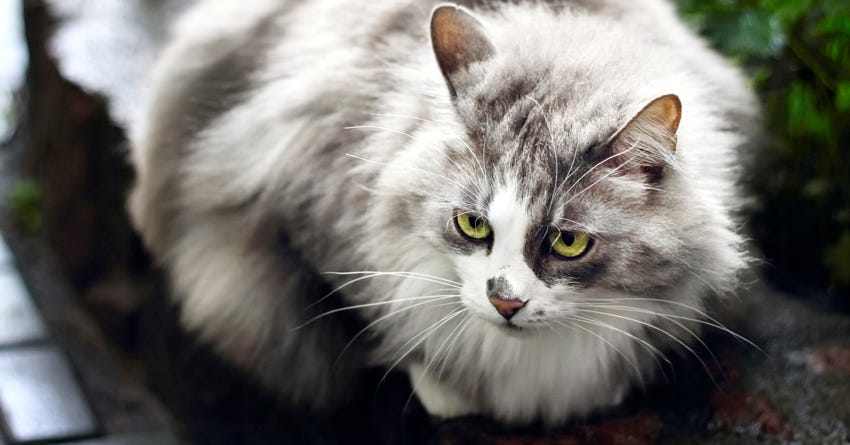For a cat, An upper respiratory infection (URI) can be compared to a cold a person might get. Both human head colds and feline URIs can be caused by a number of different things (various bacteria or viruses) and the symptoms and severity vary.
The term 'cold' for people is a catchall term applies to just about any illness that makes us sneeze and feel miserable. There is no cure for it, although we might be able to lessen the symptoms. Usually, a cold is not life-threatening, but sometimes a cold can lead to a more dangerous secondary infection. We generally have to ride it out and when it's done, it's done. A feline URI is similar, although it's caused by different agents (feline specific) than the human cold is.
Are Cat URIs Contagious?
I foster kittens that a rescue group saves from local shelters. It's more common than not that these foster kittens develop a URI because, if taken into the shelter when young, they won't have much in the way of immunities, won't have had any vaccinations and upper respiratory infections are passed from cat to cat with lightning speed in crowded conditions. Feral cat colonies are also prone to URIs for the same reason. Cats who live inside and outside can pick up the disease from a neighborhood cat. Indoor-only cats are not as prone to coming down with URIs as there is little exposure to the active disease. However, a new cat in the house can certainly bring the disease in.
Most of the time, the disease is spread through contact. An infected older cat, even the mother cat, who grooms a kitten may give it to the kitten. A sneezing cat will spread it through those sneezed out droplets of fluid to any cat within range. The diseases tend to not live long in the environment, thankfully, and disinfection procedures using diluted bleach are effective for both viral and bacterial infections.
URI Symptoms, Severity, and Diagnosis
The first symptom of a URI is usually red, watery eyes. The eyelids themselves will look sore and the cat may squint one or both eyes. Some cat owners might think the cat got something in her eye or scratched her it. Sneezes follow rapidly, usually within 24 hours of the red eyes, and the sneezing will be followed by bubbles at the nose, snorting to clear the nose and head congestion. A mild case may not progress any further than this, but some cats will also begin coughing, act as if they have a sore throat, run a fever and develop chest congestion.
In severe cases, the cat will stop eating and may have difficulty breathing. Like human colds, URIs are not generally considered life-threatening. That said, young kittens, cats with health challenges, elderly cats, cats who develop secondary infections or cats who stop eating may die. Most URIs can be treated at home, and often your veterinarian will not ask for your cat to come to the clinic. After all, your cat could then spread it to other cats there. However, if the symptoms appear to be severe (your cat is coughing, has stopped eating, or is having trouble breathing), your vet will want to examine your cat.
How to Treat Your Cat's Upper Respiratory Infection
If your cat's eyes are red, inflamed and obviously bothering him, your veterinarian may recommend an eyewash, ointment or drops to help. If the discharge from the eyes is clear, a saline wash can flush the eyes and the discharge can then be gently cleaned from the fur around the eyes. Sometimes the saline will sting, and in that case, a prescription eye ointment will be prescribed. If the discharge from your cat's eyes is no longer clear and becomes yellow, green or thick, talk to your vet as additional treatment will be needed.
Clean your cat's nose with a warm, wet paper towel. Be gentle cleaning up the nasal discharge as her nose will be sore. Your cat is still going to be trying to keep herself clean during this, even when she doesn't feel good, so her front legs may get dirty too. A warm paper towel with a drop of baby shampoo will clean the fur on her legs. If your cat has a stuffy head and is snorting or coughing, steam will help just as it does for you when you have a cold. Heat some water till it's steaming and place it on a table or counter. Holding your cat close to you, lean close to the steam and throw a big towel over both of your heads. Let the steam do its work for your cat. Five minutes is good if your cat will cooperate. Doing this several times a day, as you can, will loosen some of the mucus in her head so she can sneeze it out.
Antibiotics are usually recommended for URIs. If the agent causing the problem is bacteria, an antibiotic can shorten the duration of the disease. Although antibiotics don't cure viral diseases, they can prevent secondary infections. Which antibiotics will be prescribed depending on several factors, including what form of URI is going through the community where you live. After all, your cat didn't come down with it from nowhere; if your cat has it, so do others. Don't give your cat any medications, especially cold medications, without checking with your veterinarian first. Cats are sensitive to many medications that people and dogs can both tolerate, sometimes to the point of liver or kidney failure and death.
How to Administer Medicine for Your Cat's URI
Cat owners know giving medications to cats isn't easy. However, if you can wrap your cat in a towel (creating a kitty burrito) you can give medications without being shredded or bitten. Spread out a towel (hand towel for a kitten and full size for an adult. Place the cat on the towel with her head facing out in the middle of a long side. Pull the towel up behind her, snugly, and then pull one side up and around her, enclosing all four feet. Then bring the other side up and wrap it the other direction, snugly. Ideally, when you're done, her head is out but all four feet are safely enclosed within the wrapped towel. Next, secure your wrapped cat under one arm on the table or counter, and with that hand, gently lift one eyelid. Put in the medication without touching the eyelid or eye with the tube or dropper and release the eyelid. Repeat on the other eye.
Giving your cat liquid oral medication is easier than pills, and often using the burrito wrap isn't necessary. Have the medication measured out into the syringe or dropper. Go find your cat and set her on a table or counter and tuck her under one arm. If she isn't too reactive, you can just hold her. If she gets reactive and will scratch you, hold the scruff of her neck. Insert the dropper or syringe into the side of her mouth, pointing it into the mouth and not back out the front or other side. Release the medication and gently keep your cat's mouth closed until she swallows.
The burrito method works best for giving your cat a pill but before you wrap her, get everything ready. Have a small syringe and pull some air into it. Put a tiny dab of butter on the end of the syringe and stick the pill to the butter. Now burrito wrap your cat, tuck her under one arm, and with that hand, reach over her head and gently open her mouth. Pop the syringe with the butter and pill into her mouth, and using the air in the syringe, shoot that pill into the back of her mouth. Quickly close her mouth and rub her throat until she swallows.
What to Do When Your Cat Won't Eat During a URI
A healthy cat needs to smell her food before eating. By doing this, she will avoid spoiled food or food that's been tampered with. While this is a good survival skill, it also means that when a cat has a stuffed up nose, she will not want to eat.
Warm foods produce more odor than cold ones, so tempt your cat with some warm (but not hot) food. The Honest Kitchen's grain free, human grade cat foods are perfect for these times, since you can use warm water to mix it. Plus, they have a strong enough smell to catch your cat's attention.
Meat baby foods, like chicken or turkey and gravy, can also tempt a sick cat. These also work great if your cat has a sore throat as they are creamy and soft. If I have a kitten with a bad URI who refuses to eat, I'll mix some kitten formula with baby food and a bit of warm water. I want it liquidy but a little thick, like a melted milkshake. Using a syringe, I'll feed this to the kitten by putting a couple of drops at a time in her mouth. Usually, once the kitten begins tasting the food and swallowing, she'll take it more eagerly.
Shop Grain Free Cat Food
How Long Does a Feline URI Last?
URIs run their course in one to three weeks, depending on which bacteria or virus caused it. Your cat's state of health prior to getting sick also affects the duration of illness. A kitten, elderly cat or a cat with other health problems will have more difficulty recovering than a healthy adult cat, but don't give up. However, as you're helping your cat recover, watch for any complications and call your vet when you see any changes.


